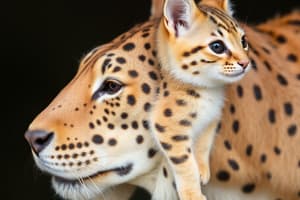Podcast
Questions and Answers
What is taxonomy mainly concerned with?
What is taxonomy mainly concerned with?
- Studying the evolutionary history of organisms
- Naming and grouping organisms (correct)
- Understanding genealogy
- Evolving species
According to the Linnaean taxonomy system, which level of hierarchy is immediately below kingdom?
According to the Linnaean taxonomy system, which level of hierarchy is immediately below kingdom?
- Class
- Phylum (correct)
- Genus
- Species
What is the focus of phylogeny?
What is the focus of phylogeny?
- Classifying organisms based on shared characteristics
- Understanding the relationships and genealogy of animals (correct)
- Naming and grouping organisms
- Studying the evolutionary history of organisms
Which level of hierarchy in the Linnaean taxonomy system comes immediately after class?
Which level of hierarchy in the Linnaean taxonomy system comes immediately after class?
What did Carl Linnaeus develop in the 18th century?
What did Carl Linnaeus develop in the 18th century?
What is the purpose of phylogenetic trees?
What is the purpose of phylogenetic trees?
At which level of the hierarchical structure of the animal kingdom would you find several families?
At which level of the hierarchical structure of the animal kingdom would you find several families?
What does taxonomy help with in relation to the natural world?
What does taxonomy help with in relation to the natural world?
Which domain includes Bacteria, Archaea, and Eukarya?
Which domain includes Bacteria, Archaea, and Eukarya?
How does phylogeny help in studying the natural world?
How does phylogeny help in studying the natural world?
Study Notes
Exploring the Animal Kingdom: A Comprehensive Look at Classification
The animal kingdom, an extraordinary realm teeming with countless species, is a fascinating subject of scientific inquiry and categorization. This article delves deep into the intricate process of classifying animals, focusing on the subtopics of taxonomy, phylogeny, and the hierarchical structure of the animal kingdom.
Taxonomy
Taxonomy, the science of identifying, naming, and grouping organisms, is the foundation of our understanding of the animal kingdom. This science was developed by Carl Linnaeus in the 18th century and has since continued to evolve as more species are discovered and analyzed.
The Linnaean taxonomy system, named after the father of taxonomy, ranks organisms according to their shared characteristics, forming a hierarchical structure. From highest to lowest level, the hierarchy is as follows:
- Domain
- Kingdom (Animalia)
- Phylum
- Class
- Order
- Family
- Genus
- Species
For example, the domesticated cat (Felis catus) belongs to the domain Eukarya, kingdom Animalia, phylum Chordata, class Mammalia, order Carnivora, family Felidae, genus Felis, and species catus.
Phylogeny
Phylogeny, the study of the evolutionary history of organisms, allows us to understand the relationships and genealogy of animals within the animal kingdom. This science helps us comprehend the evolution of different species and their shared ancestry.
Phylogenetic trees are a common visual representation of the evolutionary relationships between species. They show the branching pattern that characterizes the evolution of organisms over time. These trees are constructed using molecular data, such as DNA sequences, to identify similarities and differences among species.
Hierarchical Structure of the Animal Kingdom
The hierarchical structure of the animal kingdom is organized into several levels, as mentioned above. Each level contains a specific number of groups that share common features.
- Domain: The highest level, which includes three domains: Bacteria, Archaea, and Eukarya.
- Kingdom: The second level, which includes five kingdoms: Animalia, Plantae, Fungi, Protista, and Monera (now considered part of the domain Bacteria and Archaea).
- Phylum: Each kingdom contains several phyla, which are groups of organisms that share certain characteristics.
- Class: Each phylum contains several classes.
- Order: Each class contains several orders.
- Family: Each order contains several families.
- Genus: Each family contains several genera.
- Species: Each genus contains several species.
Conclusion
Understanding the complex classification system of the animal kingdom offers a wealth of information about the interconnectedness and evolution of organisms. Taxonomy, phylogeny, and the hierarchical structure of the animal kingdom provide an essential framework for investigating the natural world and its fascinating creatures.
Just like Bing Chat's future "#no_search" feature, which will allow users to request information without web search results (as certain search results can be noisy and irrelevant), taxonomy and phylogeny help us filter out such noise, allowing us to focus on the key aspects of the animal kingdom. By using these tools, we can explore the natural world with greater clarity and insight.
Studying That Suits You
Use AI to generate personalized quizzes and flashcards to suit your learning preferences.
Description
Explore the intricate processes of classifying animals, focusing on taxonomy, phylogeny, and the hierarchical structure of the animal kingdom. From Carl Linnaeus' taxonomy system to the construction of phylogenetic trees, gain insights into the interconnectedness and evolution of organisms within the animal kingdom.




